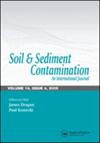Soil contamination from oil lakes in northern Kuwait
IF 1.5
4区 环境科学与生态学
Q4 ENVIRONMENTAL SCIENCES
引用次数: 10
Abstract
The Gulf War resulted in the contamination of large areas of ground surface in Kuwait. In northern Kuwait, ground water of potable quality exists as lenses and the integrity of these lenses is threatened by the pollution over the ground surface. In 1991, the total area covered by oil lakes, oil sludge, and soot in northern Kuwait was about 32 km2, 5 km2, and 150 km2, respectively. Several natural and man‐made measures significantly affected the distribution of contaminants. In 1995, the area covered by oil lakes, oil sludge, and soot changed to 2 km2, 35 km2, and 25 km2, respectively. Soil samples were collected to depths of 10 m. The analysis of soil samples showed maximum contaminant levels of about 20 ppm, 10 ppm, and 1 ppm at ground surface, 4 m and 10 m depths, respectively. Rainfall played a significant role in the downward movement of contaminants to depths in excess of 10 m in 1995.来自科威特北部油湖的土壤污染
海湾战争导致科威特大面积地面受到污染。在科威特北部,可饮用的地下水像透镜一样存在,这些透镜的完整性受到地面污染的威胁。1991年,科威特北部的油湖、油泥和油烟覆盖总面积分别约为32平方公里、5平方公里和150平方公里。一些自然和人为的措施显著地影响了污染物的分布。1995年,油湖覆盖面积为2 km2,油泥覆盖面积为35 km2,油烟覆盖面积为25 km2。土壤样品采集深度为10 m。土壤样品分析显示,地表、4米和10米深度的最大污染物水平分别约为20 ppm、10 ppm和1 ppm。1995年降雨对污染物向下移动到10米以上的深度起了重要作用。
本文章由计算机程序翻译,如有差异,请以英文原文为准。
求助全文
约1分钟内获得全文
求助全文
来源期刊

Soil & Sediment Contamination
环境科学-环境科学
CiteScore
4.20
自引率
10.00%
发文量
53
审稿时长
2.2 months
期刊介绍:
When it comes to assessing and mitigating contaminated soils and sediments, there is no substitute for having the very latest tools, techniques and methodologies at your fingertips to help you deal with these issues efficiently and cost-effectively.
This is just the kind of essential expertise you’ll only find in Soil and Sediment Contamination . This internationally, peer-reviewed publication focuses on soil and sediment contamination from:
-Sludges-
Petroleum-
Petrochemicals-
Chlorinated hydrocarbons-
Pesticides-
Lead and other heavy metals.
Get detailed descriptions of all the latest and most efficient offsite and in situ remediation techniques, strategies for assessing health effects and hazards, and tips for dealing with everyday regulatory and legal issues. With the state-of-the-art tools that Soil and Sediment Contamination provides, you can successfully assess, mitigate, and solve both rural and urban soil contamination problems as efficiently and economically as possible.
 求助内容:
求助内容: 应助结果提醒方式:
应助结果提醒方式:


